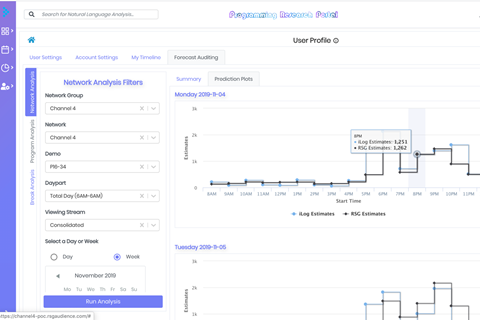The latest generation of scheduling solutions is expected to enable enterprise resource planning across multiple platforms and services, writes David Davies.

In these days of endless online choice, it would be relatively easy to assume that the importance of linear TV scheduling has diminished significantly. But although 2019 Ofcom statistics reveal that UK viewership of YouTube and SVoD is increasing, broadcast TV still accounts for 71% of the average 5 hours and 1 minute of video content watched each day – with 58% being viewed live on TV sets.
It therefore follows that an effective scheduling platform continues to be a critical element of most broadcasters’ day-to-day infrastructures. Increasingly, though, there is a need for these platforms to be more tightly integrated with programme archives and streaming technologies as broadcasters work to optimise the use of their content across different channels and services.
“It’s where the industry is going,” confirms Theodore Garcia, executive vice-president, client success at RSG Media. “We observe that very complex companies who have extensive libraries are trying to ensure their content is fully exploited across every channel and all geographical territories.”
Hence, they are now finely attuned to the importance of technologies that will help them “optimally deploy that content, whether it’s first-run or drawn from their libraries.”
‘Millions of possible schedules’
It’s no surprise to discover that AI is becoming more integral to scheduling as the amount of content to be planned continues to grow. RSG is a case in point, with its two “complementary” scheduling-related tools – RSG Advertising and RSG Audience – having been built using IBM Watson AI technology.
For commercial broadcasters, RSG Advertising provides advanced analytics to help sales teams target right-fit advertisers and then deliver optimised advertising plans and schedules. Drawing on 50-plus data sources to yield a wide range of audience insights, RSG Audience can analyse “millions of possible schedules in seconds” in order to forecast ratings and recommend programming decisions.
With data sources including the likes of Nielsen (globally), BARB (UK) and BARC (India), RSG Audience employs “a very sophisticated algorithm to forecast ratings for shows during different periods of time,” says Garcia. “This includes looking across competitor networks at specific shows and time-frames.” Complex analytics ultimately inform “a graphical representation of a programme line-up that will, of course, change until the schedule is finally locked down.”

Future scheduling tools, suggests Garcia, should be expected to reflect a number of emerging requirements, not least “the greater melding of scheduling with rights management in line with the demand by finance and sales teams to gain a holistic view of how their IP is doing, so they can ascertain whether or not it is being fully exploited.” More and more, the “holy grail for large broadcasters will be a centralised system that allows them to look at what they are doing with the IP in conjunction with performance evaluations from a revenue perspective.”
But although such complex and responsive systems will require even more sophisticated use of AI, Garcia rejects suggestions that the human role in scheduling will fade over time: “If anything, I think that the human element could become more critical as the people engaged with this will have to be adept at using AI and able to interpret the results [it provides].” Scheduling has always been “in large part an artistic endeavour; now, with these newer technologies, it can be an activity where art and science collide.”
‘Tighter integration is expected’
The importance of deeper “business intelligence and analytics” and integration with other broadcast systems is also underlined by Stefan Nied, senior director marketing and business development of ScheduALL solution developer Net Insight. “Scheduling solutions are no longer relegated to simply scheduling – we have to be seen as broad mission-critical ERP [enterprise resource planning] systems that round out the full enterprise operational and financial orchestration,” he says. “Additionally, most businesses are looking to SaaS or cloud-based solutions with effortless mobile access versus on-premise software. Organisations also desire deeper instant business intelligence and analytics, along with a broader and more seamless ability to integrate with related software and hardware systems.”
“We observe that very complex companies who have extensive libraries are trying to ensure their content is fully exploited across every channel and all geographical territories.” - Theodore Garcia, executive vice-president, client success at RSG Media.
Nied indicates that Coronavirus has “accelerated the requirements for better resource tracking and mobile access”, although it is evident that Net Insight was already substantially down the road of enabling “tighter integration” between broadcast and IT systems. He explains that such “integrations eliminate redundant data entry, duplication of work, and risk of errors while providing increased efficiencies and immediate reduction in workload with increased capacity.”
In terms of specific Net Insight solutions, ScheduALL “has employed our Chorus interoperability tool for many years for web service APIs and is developing a new Enterprise Service Bus (ESB} to further facilitate interoperability. This ESB also feeds directly into the inner working of our SaaS Evolution solution.”
With Evolution, AI already “plays a crucial role in effortless and smart scheduling, crewing and scenario planning; this will only advance over the next few years. ScheduALL Analytics also provides AI in the form of sophisticated prescriptive analytics that help companies make solid business decisions moving forward where simple historical data reporting falls short. Data visualisation tools are employed to graphically provide predictive insights…”
‘Scheduling linear and non-linear’
For VSN the focus is now increasingly on providing scheduling tools that can facilitate both linear and non-linear programme planning. “More and more there is a demand [for technologies] that make it possible to achieve a combination of both,” confirms VSN marketing director Patricia Corral Álava.

Acknowledging that different broadcasters will take contrasting approaches, VSN continues to focus on workflow versatility with VSNCrea, which is the company’s traffic and scheduling solution for TV, radio and non-linear channels. Entirely web-based, VSNCrea enables the management of a company’s content production catalogue – either owned or acquired from third parties – as well as its advertising production workflows, programming and broadcast planning.
For the next phase of its development VSN is favouring a “modular approach” that will allow broadcasters to plan and schedule content for linear and non-linear services, as well as social media channels, websites and radio. It is clear that there will be a growing demand for “an easy tool that allows broadcasters to organise, plan and schedule content for different platforms and in different formats,” says product manager Toni Vilalta. “Within that there will be scope to automate a great majority of daily tasks, which will also help avoid human error.”
With more and more content to administer, the expectations of content metadata will also become more acute – hence VSN’s development of a “custom metadata tool that allows the broadcaster to create new fields that reflect their specific requirements.” More generally, platform versatility will be more highly prized “as the behaviour of viewers continues to change” – probably on a more frequent basis than used to be the case.
Returning to Garcia’s observation about the role of “art and science” in scheduling, it is probable that the fusion of the two will have to be evermore finely calibrated in the future. Not only will the volume of content that has to be scheduled continue to rise, its dissemination – across different platforms and channels – will need to be fully optimised to build customer retention and minimise viewer fatigue. Plenty for developers to think about, then, as they plot the next generation of integrated scheduling solutions.
- Read more: The second streaming revolution



























No comments yet